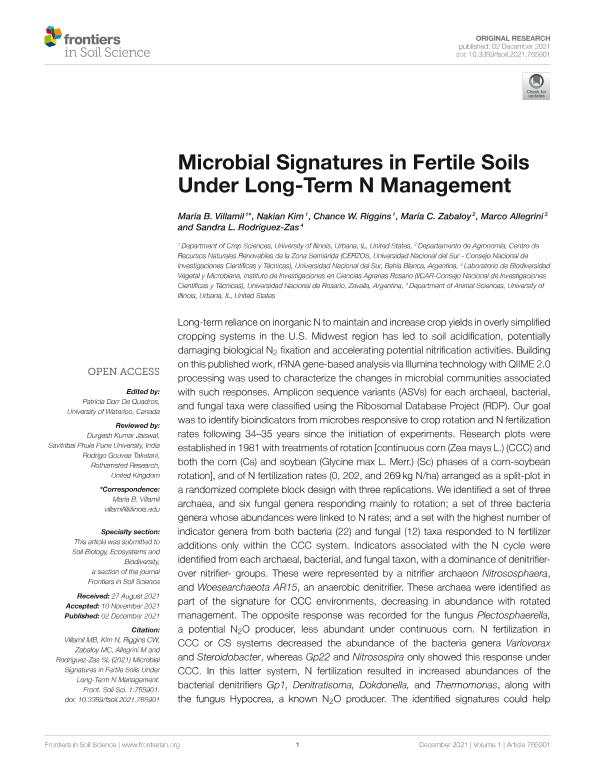Artículo
Microbial Signatures in Fertile Soils Under Long-Term N Management
Villamil, Maria Bonita ; Kim, Nakian; Riggins, Chance W.; Zabaloy, Maria Celina
; Kim, Nakian; Riggins, Chance W.; Zabaloy, Maria Celina ; Allegrini, Marco
; Allegrini, Marco ; Rodríguez Zas, Sandra L.
; Rodríguez Zas, Sandra L.
 ; Kim, Nakian; Riggins, Chance W.; Zabaloy, Maria Celina
; Kim, Nakian; Riggins, Chance W.; Zabaloy, Maria Celina ; Allegrini, Marco
; Allegrini, Marco ; Rodríguez Zas, Sandra L.
; Rodríguez Zas, Sandra L.
Fecha de publicación:
02/12/2021
Editorial:
Frontiers Media
Revista:
Frontiers in Soil Science
e-ISSN:
2673-8619
Idioma:
Inglés
Tipo de recurso:
Artículo publicado
Clasificación temática:
Resumen
Long-term reliance on inorganic N tomaintain and increase crop yields in overly simplified cropping systems in the U.S. Midwest region has led to soil acidification, potentially damaging biological N2 fixation and accelerating potential nitrification activities. Building on this published work, rRNA gene-based analysis via Illumina technology with QIIME 2.0 processing was used to characterize the changes in microbial communities associated with such responses. Amplicon sequence variants (ASVs) for each archaeal, bacterial, and fungal taxa were classified using the Ribosomal Database Project (RDP). Our goal was to identify bioindicators from microbes responsive to crop rotation and N fertilization rates following 34?35 years since the initiation of experiments. Research plots were established in 1981 with treatments of rotation [continuous corn (Zea mays L.) (CCC) and both the corn (Cs) and soybean (Glycine max L. Merr.) (Sc) phases of a corn-soybean rotation], and of N fertilization rates (0, 202, and 269 kg N/ha) arranged as a split-plot in a randomized complete block design with three replications. We identified a set of three archaea, and six fungal genera responding mainly to rotation; a set of three bacteria genera whose abundances were linked to N rates; and a set with the highest number of indicator genera from both bacteria (22) and fungal (12) taxa responded to N fertilizer additions only within the CCC system. Indicators associated with the N cycle were identified from each archaeal, bacterial, and fungal taxon, with a dominance of denitrifier over nitrifier- groups. These were represented by a nitrifier archaeon Nitrososphaera, and Woesearchaeota AR15, an anaerobic denitrifier. These archaea were identified as part of the signature for CCC environments, decreasing in abundance with rotated management. The opposite response was recorded for the fungus Plectosphaerella, a potential N2O producer, less abundant under continuous corn. N fertilization in CCC or CS systems decreased the abundance of the bacteria genera Variovorax and Steroidobacter, whereas Gp22 and Nitrosospira only showed this response under CCC. In this latter system, N fertilization resulted in increased abundances of the bacterial denitrifiers Gp1, Denitratisoma, Dokdonella, and Thermomonas, along with the fungus Hypocrea, a known N2O producer. The identified signatures could help future monitoring and comparison across cropping systems as we move toward more sustainable management practices. At the same time, this is needed primary information to understand the potential for managing the soil community composition to reduce nutrient losses to the environment.
Palabras clave:
ARCHAEA
,
BACTERIA
,
FUNGI
,
NIITROGEN
,
MAIZE
,
SOYBEAN
,
MONOCULTURE
,
ROTATION
Archivos asociados
Licencia
Identificadores
Colecciones
Articulos(CERZOS)
Articulos de CENTRO REC.NAT.RENOVABLES DE ZONA SEMIARIDA(I)
Articulos de CENTRO REC.NAT.RENOVABLES DE ZONA SEMIARIDA(I)
Articulos(IICAR)
Articulos de INST. DE INVESTIGACIONES EN CIENCIAS AGRARIAS DE ROSARIO
Articulos de INST. DE INVESTIGACIONES EN CIENCIAS AGRARIAS DE ROSARIO
Citación
Villamil, Maria Bonita; Kim, Nakian; Riggins, Chance W.; Zabaloy, Maria Celina; Allegrini, Marco; et al.; Microbial Signatures in Fertile Soils Under Long-Term N Management; Frontiers Media; Frontiers in Soil Science; 1; 02-12-2021; 1-22
Compartir
Altmétricas



